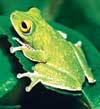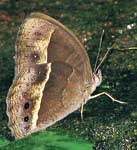
Help!The National Red List of Threatened Plants and Animals in Sri Lanka reveals alarming statistics How much of Sri Lanka’s celebrated wildlife will we have left 25 years hence? Today, a herd of wild elephants coming to drink at a tank is a common sight in Yala, Minneriya and many such places in the island. However, if the dangerous trend of encroaching on the natural habitat of these animals continues, the next few decades could see some of Sri Lanka’s most majestic animal species becoming extinct.
The elephant (Elaphas maximus) is listed as ‘vulnerable’ and it comes as no surprise given that the death of a wild elephant is reported every two days. Also in the ‘vulnerable’ category are the Sri Lankan leopard (Panthera pardus) and the wild buffalo (Bubalus arnee), while the sloth bear (Melursus ursinus) is listed as ‘endangered’. One in every two species of mammals and amphibians, one in every three species of reptiles and freshwater fish and one in every five species of birds in the country are currently facing the risk of becoming threatened in the wild. The alarming statistics are revealed in the 2007 National Red List of Threatened Plants and Animals in Sri Lanka compiled by the World Conservation Union (IUCN), in collaboration with the Biodiversity Secretariat of the Ministry of Environment and Natural Resources. The list was prepared by gathering information on the indigenous flora and fauna of Sri Lanka and assessing their conservation status, taking into consideration the Global Red List criteria developed by the IUCN. “The Red List is both an important and powerful tool in the conservation cause,” says Dr. Channa Bambaradeniya, Coordinator, Regional Species Conservation Program, IUCN Asia. “It is a good indicator of the current status of wildlife, and it focuses our attention on the seriousness of the threats to the unique and rich biodiversity of Sri Lanka.”
Species were considered as nationally threatened when evaluated as one of the following: Critically Endangered (CE), Endangered (EN), or Vulnerable (VU). The state of indigenous species in Sri Lanka was determined by the rate of population reduction, restricted geographic range, small population size and very small or restricted population. Most species were evaluated using their geographic range (Extent of Occurrence-EOO and Area of Occupancy-AOO). The National Red List was presented to the Minister of Environment and Natural Resources, Champika Ranawaka on Wednesday. Speaking at the ceremony, the Minister stressed the importance of a concerted effort on the part of every citizen. “The National Red List is without doubt the most important environmental document; it sounds alarm bells as to what is happening, and tells us that we all need to act now, to save what is left of our precious wildlife,” he said. The process of compiling the National Red List began in 2004. Facts were assembled selecting certain taxonomic groups for evaluation. Species information was then fed to a digital database, and the distribution of each species plotted in a 5x5 km² grid map using GIS technology. The result is what is considered the most comprehensive document concerning the environment and its conservation. “The previous National Red List was compiled in 1999, and the findings of the current assessments suggest that although steps have been taken to mitigate the threat of extinction, this effort is far from enough,” explained Ms. Shiranee Yasaratne, the country representative of IUCN. Sadly, the animals on the previous Red List are in much the same or in a worse situation than they were eight years ago. Climate change induced by rapid global warming, deforestation and pollution are some of the main threats to wildlife. Poaching is also a serious threat, and although steps have been taken towards restricting this activity, it continues regardless.
Aquatic habitats and endemic fish species are in grave danger due to excessive use of agrochemicals- Sri Lanka ranks high among the top ten countries that make use of these chemicals. Deforestation, mining of minerals, improper land use etc have led to heavy siltation in streams and rivers affecting aquatic life. According to the National Red List, 223 (33%) inland indigenous vertebrate species are classified as nationally threatened. Of these, as many as 138 species (62%) are endemic to Sri Lanka. Local extinction has already been happening due to urbanization. 84 vertebrates and 74 invertebrates have been classed in the near threatened category. Many of these reside in the wet zone of Sri Lanka. Only 4% of the wet zone is forested, and these forests too are severely fragmented. The implication of habitat loss, particularly in the wet zone, is that 21 species of endemic amphibians and 72 species of plants have become extinct over the past two centuries. In the past fifty years, we have lost approximately half of the country’s total forested area. As of now, only 23.5% of the island’s forests remain. The loss of forests averages as much as 30,000 hectares per year. Plant life in Sri Lanka too faces similar dangers. Of the island’s total number of plant species (1099) evaluated, a staggering 61% are threatened. Of these, a further 61% are endemic to Sri Lanka. Thirty-seven percent of these endemic plants are in the critically endangered category.
Unfortunately, the full implications of the extinction threat are unknown. In the case of plant life, only 30% of indigenous plants have been evaluated due to problems related to the lack of access to recent taxonomic publications and inconsistency in published data to name a few. Thus, some species have been put into the Data Deficient category. It is possible that many of these species are already threatened and in need of conservation action.
The 2007 National Red List, along with the new digital database launched by IUCN should be of some help to conservationists. With these tools, conservation planning and monitoring of protected areas, the creation of more public awareness and finally minimizing the threat of extinction could be achieved. Much remains to be done, both by the public and environmental organizations. In a bid to enlarge the size of wildlife reserves, efforts are being made to regenerate forests and link protected areas together by way of what are known as habitat corridors. “So far, these steps have been undertaken on a small scale, but even a small effort is a significant contribution to this cause,” said Dr. Bambaradeniya. We all want the promise of a better tomorrow. For a large section of our wildlife, there could well be no tomorrow. Children in the 2020’s may have to look up encyclopedias and visit museums to see animals that we are familiar with today. It is time to put things right. Not too far from now, it could be too late. |
|| Front
Page | News | Editorial | Columns | Sports | Plus | Financial
Times | International | Mirror | TV
Times | Funday
Times || |
| |
Reproduction of articles permitted when used without any alterations to contents and the source. |
© Copyright
2007 | Wijeya
Newspapers Ltd.Colombo. Sri Lanka. All Rights Reserved. |






